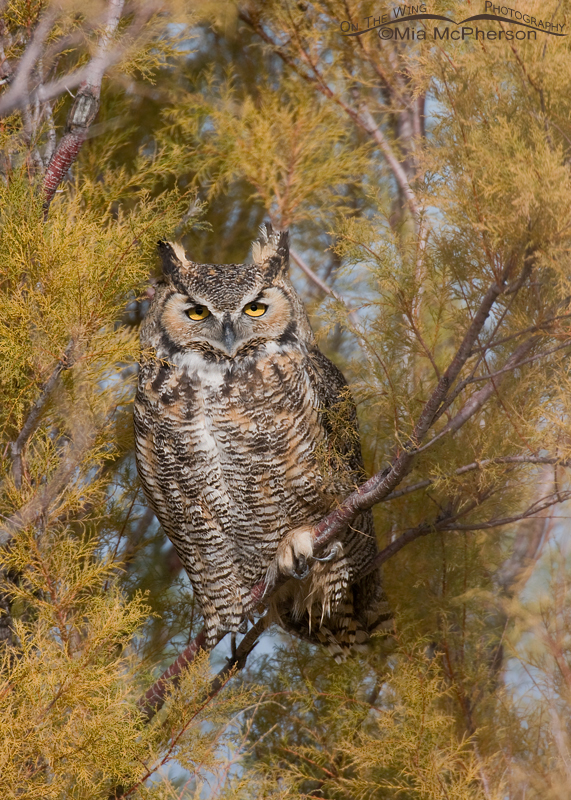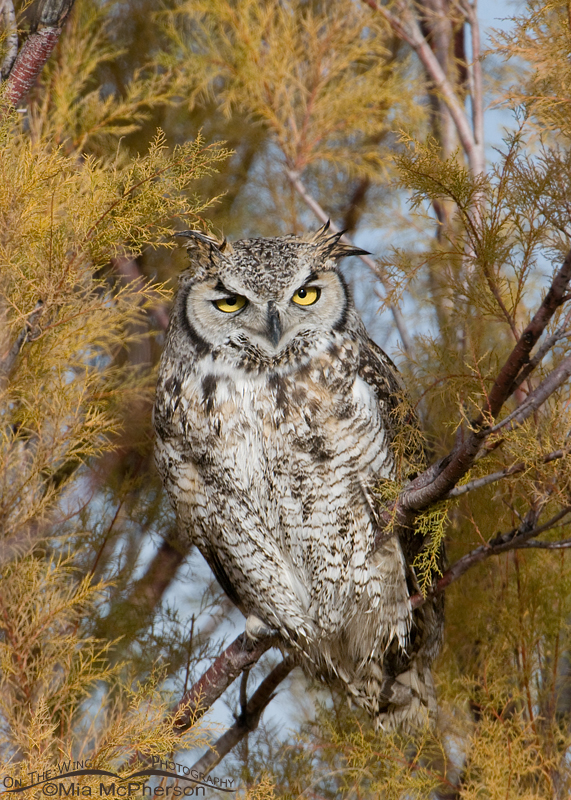Great Horned Owls
 Great Horned Owl – November 11, 2011 – Nikon D300, f6.3, 1/1000, ISO 400, +0.3 EV, Nikkor 200-400mm VR with 1.4x TC at 400mm, natural light, not baited or set up
Great Horned Owl – November 11, 2011 – Nikon D300, f6.3, 1/1000, ISO 400, +0.3 EV, Nikkor 200-400mm VR with 1.4x TC at 400mm, natural light, not baited or set up
Normally I think of myself as very observant. I often see birds in the field before the other photographers who might be in the field with me. I can spot just a part of an animal and know that they are there. When I am in the field my eyes are constantly scanning my surroundings on the land and in the air. I’ve gotten to know several locations very well and can spot a bump on a sagebrush that shouldn’t be there that turns out to be a bird. I once noticed a rock that looked out of place. Well it was a very dark Porcupine.
But I have found that sometimes I need to fine tune my vision even further.
On the 11th of November I spotted this Great Horned Owl (Bubo virginianus) in a Tamarisk and photographed it, after seeing where it was perched I started to routinely look for it from a road above where the owl has been roosting. On the 22nd of November I saw a familiar shape in the same Tamarisk and went down to photograph what I believed to be the same owl that I had photographed on November 11th.
 Great Horned Owl – November 22, 2011 – Nikon f7.1, 1/1600, ISO 640, +0.7 EV, Nikkor 200-400mm VR with 1.4x TC at 400mm, natural light, not baited or set up
Great Horned Owl – November 22, 2011 – Nikon f7.1, 1/1600, ISO 640, +0.7 EV, Nikkor 200-400mm VR with 1.4x TC at 400mm, natural light, not baited or set up
I took many images of the owl I spotted on the 22nd of November and though I wished then that the bird had chosen a more open location to roost I was happy with the images I took.
After editing a few images from the second session with the Great Horned Owl in the Tamarisk I uploaded three of the images to my photo galleries and when I went to the gallery to verify that they had uploaded correctly I saw somethings immediately that I had not seen in the field.
The Great Horned Owl I photographed on November 22nd was NOT the same owl I had photographed on November 11th.
When I had the images side by side I quickly noticed that the owl I photographed on November 11th had rustier coloration in the facial disk, forehead and body. That owl also has more barring of the chest.
The Great Horned Owl I photographed on November 11th had more white on the chest, less barring and the facial disk was grayer.
I’m excited that two Great Horned Owls are using the same roosting location and from now on I will be looking more closely to determine which of the two I am seeing.
Who knows; maybe I’ll be surprised and spot a third owl in that same location.
Life is good.
Mia
Click here to view more of my Great Horned Owl photos plus facts and information about this species.


I would consider, being seen in the same territory in November, that these two birds most probably are a pair.
I think they might have been a pair too Larry. Since I wrote that post those Tamarisks have been cut down, hopefully these two found another place to build a love nest! Thanks for commenting.
Always nice to find any owl in daylight and get a decent image, wonderful shots (both of them).
Jim, it is always wonderful to find owls in daylight. They are such gorgeous birds.
How common is it for this species to sit on open perches? I really like the environment you captured these two in. You really got most of the bird and a lot of detail as well, as you always do. I think it is so interesting that they are almost at the exact same spot on the same perch 11 days apart, but I have never seen an owl in the wild, much less photographed one. Is it more probable to see them in the morning or evening?
Julie, I only know of a few places here where the Great Horned Owls sit out in the open. In Florida I mainly found them in the pines. I usually see them in the mornings out here.
I have noticed that Great Horned Owls are pretty dedicated to their favorite roosts and I’ll find the male and females occupying it regularly. I think the owl on the 22nd is the male (smaller) and the female was on the 11th (quite a bit larger).
Robert, I’m not sure of the genders but I do love seeing them roosting where I can photograph them!
Beautiful photos and interesting post!
Thanks so much Scott!
Great photos of the Great Horned Owl. It reminds me that about a month ago, we saw a juvenile in the trees, and it was being harassed by 3 mockinbirds. They would literally fly into while it was perched and pummel it with their bodies. It would try to fly a bit, and the mockingbirds would go at it again. Quite a confrontation before the owl was able to make a clean getaway.
Happy Hunting for that third one, Mia.
How wonderful to see two Great Horned. They are gorgeous. I always think of myself as pretty observant too, until my wife comes with me and ends up spotting everything before me – I think I might need glasses.
dan
Hi Mia:
I to took the same photos and when I read your article it made alot of sense. The first one was larger and to the west of the other spotting. Paul Higgins said on PBASE the second one was a female.
Thanks for your observation.
Earl,
Thanks for letting me know what Paul Higgins thought about the gender of the second bird. Without having a male and female present I am usually not comfortable with determining the sex of a Great Horned Owl.
In my shots from the 11th and 22nd both owls were in the same Tamarisk, perched on the same branch and until I processed the second set of images I had assumed they were the same bird. I’ll be more careful from now on.